For this church:    |
|
IN GLORIOUS AND INVICTIS PAX |
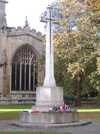 The
Cross of Sacrifice The
Cross of Sacrificein the east churchyard |
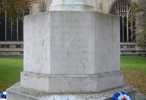 The
inscription on the The
inscription on thebase of the cross |
St George’s Chapel
This was designed by WD Caroë of Westminster. An appeal was launched in 1919 to meet the cost, and donations were received from townspeople, and also from the 1/8th and 2/8th Battalions of the Sherwood Foresters, the Sherwood Rangers Yeomanry, and the Magnus Grammar School. The Sherwood Foresters contributed generously, and also provided a substantial part of the furnishings and equipment for the chapel, including the screen, reredos, altar table and Roll of Honour. The Sherwood Rangers provided four panels on the north side of the chapel, and the Magnus Grammar School a large panel with fretwork carving on the south side. The chapel was completed in 1921, and dedicated in October of that year.
At the centre of the reredos is the figure of St George, holding in his left had a banner and in his right a sword with which he has slain the dragon beneath. The initials of the Sherwood Foresters are incorporated in the fretwork carving at the top of the reredos, and the badges of the 1/8th and 2/8th Battalions are in the panels to the sides. Above and to the sides of the figure of St George are the words:
TO OUR GLORIOUS DEAD THESE DIED IN WAR THAT WE IN PEACE MIGHT LIVE; THEIR NAME LIVETH FOR EVERMORE |
The altar itself is carved of oak.
The altar frontal was given by ladies of the county, supporters of the 8th Battalion. It bears the words:
GOD SO LOVED THE WORLD
and the design also includes four lifebelts, each bearing the name Bellenglise, commemorating a famous victory in which the 1/8th Battalion was engaged. The original frontal was replaced in 1968.
The original altar cross was given by Rev JP Hales DSO, the Battalion chaplain, and was the actual one used by him in the trenches at Ypres, but unfortunately it was later stolen.
The window behind the St George’s Chapel altar, although it dates from the nineteenth century, might be felt to be in an appropriate theme, depicting as it does the agony of Christ and four miracles of healing.
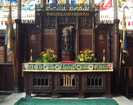 The
St George’s The
St George’sChapel altar |
 The
Magnus Grammar School board The
Magnus Grammar School board |
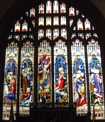 The window The windowbehind the altar |
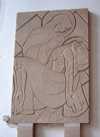 The
Kiddey Pietà
The
Kiddey Pietà
The sculptured panel in the south transept is by Robert Kiddey, a Newark artist and sculptor. It is set up above Books of Remembrance as part of the town’s memorial to the fallen of both World Wars. It takes the form of a pietà, i.e. a depiction of Mary the Mother of Jesus weeping over his body as she receives it from the cross.






